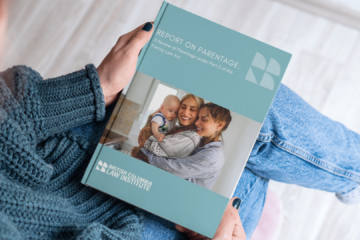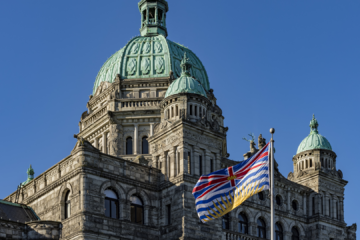An Overview of the COVID-19 Long-Term Care Visitor Policies Across Canada
January 11, 2021
BY Nicole Freeman

Nicole is currently a third-year law student at University of Victoria. She completed her undergraduate degree at University of Alberta where she obtained a BSc with a Specialization in Mathematics.
Nicole is particularly interested in law and policy, as well as improving access to justice in Canada. In her spare time Nicole enjoys cross-stitching, boxing, and exploring Victoria’s many beaches with her partner and small senior dog.
All provinces and territories in Canada have some form of COVID-19 visitation policy or guideline for long-term care facilities. This blog provides brief summaries of the COVID-19 visitation policies adopted by Canadian provinces and territories. Links to the full policies and public health orders are included where more details can be found. This information is up to date as of January 4, 2021.
British Columbia
BC’s COVID-19 visitation policy for long-term care and assisted living outlines rules for social/family visitors and essential visitors. Social/family visitors are only permitted if there is no current outbreak. If there is an outbreak, then only essential visits are permitted.
- Social/Family Visitors: Residents can designate one person to be their social/family visitor. The resident cannot change who their designated visitor is.
- Essential Visitors: The management at the individual facility decides whether an essential visitor is allowed. Reasons that essential visits may be allowed include when the resident is at end-of-life, when it is necessary for the physical or mental health of the resident, for communication assistance, or for supported decision-making.
- End of Life Visitors: If a resident is at end-of-life then more than one visitor may be permitted, as determined by the facility.
For more information on BC’s COVID-19 restrictions, see:
- Long-term care and assisted living visitor guidance
- General information on COVID-19
- Public Health Orders
Alberta
Alberta’s COVID-19 visitation policy for long-term care outlines the rules for general visitors and designated family/support persons. A general visitor is not involved with a resident’s health care and usually visits for social reasons. Up to five general visitors may be permitted to visit the resident outdoors if doing so is consistent with current public health measures. Indoor visits by general visitors are generally not permitted.
The resident may designate up to two adults to be their designated family/support person. They are friends or family members who are essential to the physical and mental health of the resident. When a resident is receiving palliative or end-of-life care then a designated family/support person can visit as much as required. A resident receiving this care may have up to three visitors at one time.
For more information on Alberta’s COVID-19 restrictions, see:
Saskatchewan
Saskatchewan’s general COVID-19 policy defines three levels of transmission from one (lowest) to three (highest). Each level corresponds to a different set of visitation rules with increasing restriction.
In long-term care, only allows family members or other support persons are allowed to visit a resident. At level one, the resident may designate up to two family or supporters who can visit. One person is permitted to visit the resident at a time when indoors, and two people may visit when outdoors. At level two, visits are only permitted for compassionate reasons or when a resident is receiving end-of-life care. When a facility is at level three then family members are only permitted when the resident is receiving end-of-life care.
As of November 19, 2020, only one healthy family member is permitted to visit at a time for compassionate reasons only. Compassionate care reasons include support for residents during end-of-life care, or to support long-term care residents whose quality of life or care needs are unmet.
For more information on Saskatchewan’s COVID-19 restrictions, see:
Manitoba
Manitoba has a general COVID-19 policy that defines three levels of pandemic response: critical/red (highest), restricted/orange, and caution/yellow (lowest). As of November 12, 2020, the entire province moved into the critical/red level.
Manitoba’s visitation policy outlines the rules for general visitors and designated family caregivers. A general visitor is someone who visits for social reasons. These visitors are not permitted at the critical/red level and are only permitted outdoors at the restricted/orange level. At the lowest level, (caution/yellow), indoor visits with general visitors may be permitted on a case-by-case basis.
A resident may designate up to two people to be their designated family caregivers. These people provide care and support to the resident. Designated caregivers must visit one at a time, but can visit at any time and can stay for any length of time.
When a resident is at end of life, at the critical/red level one general visitor and two designated family caregivers can visit a resident at the same time. At the restricted orange level, the resident can two general visitors and two designated family caregivers at the restricted/orange level. More visitors may be permitted at the lowest (caution/yellow) level.
For more information on Manitoba’s COVID-19 restrictions, see:
- Long-term care resources, including visitation rules
- General COVID-19 Information
- Public Health Orders
Ontario
Ontario’s general COVID-19 policy includes a system of five levels: grey (lockdown), red (control), orange (restrict), yellow (protect), and green (prevent). Ontario currently has areas at all levels
Ontario’s COVID-19 visitation policy for long-term care facilities outlines rules for general visitors and essential visitors. General visitors visit for social reasons. At the green or yellow level, a resident may have up to two general visitors at a time. Residents should be allowed a general visitor at least once per week. If there is an outbreak at the facility, the resident is self-isolating, or the area is at orange, red, or grey level, then general visitors are not permitted.
A resident may designate up to two essential visitors who perform essential support services for them. The home’s visitor policy must define who an essential visitor is for that facility. The long-term care policy requires that the essential visitor definition includes visitors when a resident is at end of life or very ill, essential support services, other support workers, and caregivers. Caregivers are designated by the resident and provides direct care for the resident, such as feeding, mobility assistance, aid with personal hygiene, cognitive stimulation, help with communication, meaningful connection, and assistance in decision making. At the green or yellow level, two essential visitors may visit at one time. At the orange, red, or grey level, if the home has an outbreak, or if the resident is self-isolating, only one caregiver may visit at a time.
For more information on Ontario’s COVID-19 restrictions, see:
Quebec
Quebec’s general COVID-19 policy defines four levels of alert: red (highest), orange, yellow, and green (lowest).
Quebec’s COVID-19 visitation policy describes rules for visitors and informal caregivers. A visitor is someone who is not a close or immediately family member and not an informal caregiver. An informal caregiver is someone who provides support to a resident with a disability and has an emotional bond with but does not have to be an immediate family member.
At the green or yellow levels, up to two visitors or informal caregivers can visit the resident at the same time. At the orange or red level, or when there is an outbreak at the facility, no visitors are allowed but informal caregivers can continue to visit. When a resident is at end of life both visitors and informal caregivers are permitted to visit, regardless of the current alert level.
For more information on Quebec’s COVID-19 restrictions, see:
Newfoundland and Labrador
Newfoundland and Labrador’s general COVID-19 policy defines five levels of alert from one (lowest) to five (highest). The province is currently at level two.
Newfoundland and Labrador’s COVID-19 visitation guidelines set out the rules for designated visitors and support persons. A resident may designate up to five people to be their designated visitors. A resident may designate one support person. A support person or designated visitor can be anyone the resident chooses. Up to two people may visit a resident per day, and they are permitted to visit at the same time. This includes both support persons and designated visitors.
When a resident is receiving end-of-life care they may designate a primary support person who is not limited to one daily visit. All immediate family members of the resident are permitted to visit once per day. Two people can visit at the same time. When the resident nears end-of-life then individuals are not limited to visiting once per day.
For more information on Newfoundland’s COVID-19 restrictions, see:
Nova Scotia
Nova Scotia’s COVID-19 long-term care directive sets out the rules for general visitors and designated caregivers. Visitors are friends or family members. A designated caregiver is a family member or support person. As of December 21, 2020, visitation is allowed in long-term care facilities. Even if general visitors are restricted, designated caregivers are still allowed to visit.
Exceptions to the visitation rules may be made when a resident is receiving end-of-life care. Only one visitor may be permitted at a time if such exceptions are made. These exceptions are made on a case-by-case basis.
For more information on Nova Scotia’s COVID-19 restrictions, see:
New Brunswick
New Brunswick has a system of four alert levels: red (highest), orange, yellow, and green (lowest). Areas in New Brunswick are currently at yellow and orange levels.
New Brunswick’s COVID-19 visitation guidance for long-term care facilities sets out the rules for visitors and designated support persons. A breakdown of visitation at different alert levels can be found here. For general visitors indoors, general visitors are not allowed at the red and orange level. At the yellow level: 20% of residents can have general visitors in one day. General visitors are permitted outdoors at the yellow level and orange level, but not the red level.
The resident may designate up to two people to be their designated support persons. These are people who help maintain the resident’s health. They are permitted to visit at any level.
A resident may have indoor visitors when they are at end-of-life in all levels. One or two visitors may visit the resident at one time.
For more information on New Brunswick’s COVID-19 restrictions, see:
Prince Edward Island
Prince Edward Island’s long-term care visitation guidelines list rules for visitor and partner in care. At the ‘new normal’ phase of restrictions, there is no limit on the number of visitors who can visit a resident at one time. A resident may designate up to three people to be their partners in care. These are people who provide companionship, comfort, mobility, feeding, and socializing to the resident. For residents at end of life, here is no limit to the number of bedside visitors who live in the Atlantic provinces.
From December 18, 2020 to January 11, 2021, PEI instated ‘Post Circuit Breaker Holiday Measures’. At this level, two partners in care can visit, and a limited number of visitors are allowed in designated areas.
For more information on PEI’s COVID-19 restrictions, see:
Yukon
The Yukon’s COVID-19 visitation guideline for long-term care facilities sets out the rules for general visitors, designated essential care visitors, and designated end of life essential care visitors. The resident or their substitute decision-maker can identify up to four visitors, including both designated essential care visitors and general visitors. Residents may be allowed to have a designated essential care visitor if the resident’s quality of life or care needs can’t be met. The resident care manager must approve requests for an essential care visitor.
When a resident is at end of life, they can designate up to five end of life essential care visitors. One or two visitors may visit the resident at one time.
For more information on Yukon’s COVID-19 restrictions, see:
- Long-term care visitation guidelines
- General COVID-19 information
- Description of provincial COVID-19 orders and directions
Northwest Territories
In Northwest Territories, a long-term care resident may designate up to two essential visitors. Essential visitors can only visit one at a time. When a resident is receiving palliative care, they can designate up to six people as visitors. Up to two people can visit at the same time.
For more information on Northwest Territories’ COVID-19 restrictions, see:
- Health and Social Service Authority Visitor Restrictions and Processes
- Northwest Territories Public Health Orders
Nunavut
Nunavut does not have a set visitation policy for long-term care. The province reassesses the risk level in each region every two weeks and decides what restrictions should be in place. The Path Forward document identifies visitors to long-term care as a medium risk measure. As of December 28rd:
- Arviat & Whale Cove: no visitors are allowed in long-term care
- Baffin, Kitikmeot, Chesterfield Inlet, Baker Lake, Coral Harbour, Naujaat, & Rankin Inlet: Two visitors from the resident’s immediate family is allowed
For more information on Nunavut’s COVID-19 restrictions, see:
- Nunavut’s Path, listing current public health restrictions and guidelines
- Department of Health COVID-19 information page
- Department of Health Services COVID-19 case updates












































